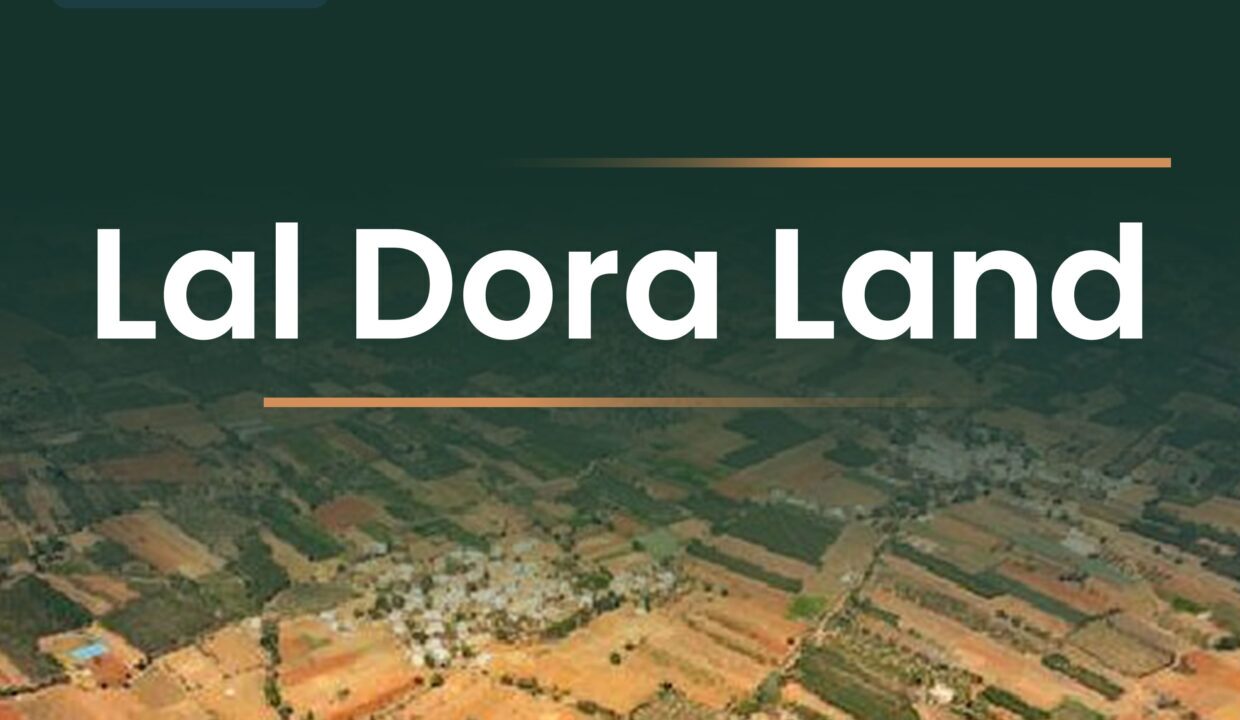
Lal Dora land refers to lands within villages that are in Delhi and some other parts of India, which were marked in 1908 by the British with a red line on revenue maps. This “Lal Dora” (red thread) was the designation between the village habitation area (Abadi) and agricultural land.
To begin with, Lal Dora land did not comply with building and municipal bylaws, since the residents could just build homes or shops without formal approval. Simply put, there was no infrastructure in place, and the properties typically had poorly defined legal titles, making ownership and development convoluted as it stands today.
Can Lal Dora property be registered in Delhi?
Yes, it is possible to register Lal Dora properties in Delhi, although the process may be slightly more prolonged than the process of registering standard urban properties because of their special history and land status. Registration of Lal Dora property is possible if the property follows relevant state policies about village land, urbanisation and building.
What is the Lal Dora System?
Lal Dora is a unique and legacy land classification system that is specific to Delhi, which represents the village abadi (residential) areas. Lal Dora Property has some limitations on construction; however, if the Lal Dora land has a clear title, proper documentation, and they are registered with the local or state government, they are completely legal and safe to buy.
What is the Lal Dora scheme?
There is no such scheme as the Lal Dora scheme, but the government is trying to integrate Lal Dora property through the SVAMITVA scheme. SVAMITVA is a central sector scheme that seeks to develop digital property records and provide property cards to residential areas in villages using drone technology.
While Lal Dora focuses on defining the area of the village that has revenue and where there are inhabited (Lal Dora Property) and uninhabited land (Khasra) areas, SVAMITVA seeks to develop digital property records of individual properties with bordering access within that area of habitation.
What are the benefits of Lal Dora property?
If you’re thinking of buying land in Delhi in a Lal Dora village and area, you may find some advantages, especially as compared to purchasing land in regulated municipal areas in India.
Possible advantages:
- Affordability – Properties in Lal Dora have tended to be less expensive to buy than the same property in fully urbanised or regulated areas.
- Less tax – Lal Dora properties historically have not had to pay property tax or house tax, particularly if the plot of land is under an area size (e.g., 200 sq m).
- Relaxed exempt from certain bylaws – Land in Lal Dora was originally granted exemption from some building bylaws and construction norms, so the owners had some flexibility around building and modifying the structures. However, like all land owners, you need to be aware of any potential local regulations and safety standards that might apply (or emerge).
- Possibility of good return on investment – the closer urban areas grow, the more affordable housing in cities will increase in demand, and there is a greater likelihood that Lal Dora properties will appreciate in value and provide a return on investment.
- Location – A lot of Lal Dora villages are geographically located very close to highly desirable commercial and residential urban centres and within the regions of major population centres that offer good connections and future potential.
- Agricultural land preservation – Lal Dora areas in Delhi may aid local agricultural land within their boundaries.
What is the interest rate of Lal Dora property loan?
Interest rates for Lal Dora property loans are very different depending on the lender and the borrower’s credentials.
Generally, we observe that the burden of interest rates for Lal Dora properties is usually in the range of 9% p.a. to 12% p.a.
Because Lal Dora Lands fall under an area historic designation that has its own procedures, and may or may not have formal documentation, you might get slightly higher interest rates than standard home loans or Loans Against Property (LAP) on standard accepted properties.
Can we get a home loan on Lal Dora property?
Yes, it is possible to get a home loan or loan against property (LAP) for Lal Dora property in Delhi and NCR.
In the past, Lal Dora Lands were mostly agricultural land with restricted building rules. Because of this, banks were hesitant to give loans as this property was vulnerable (not a traditional mortgage the bank is used to seeing) and had little demand, as most of the land was farmland or unusable agricultural land.
Demand for Lal Dora property over the years has increased; many Lal Dora properties are well connected to roads or even the metro. Some banks and NBFCs have started to lend funds for properties in Lal Dora under certain conditions.
What is a Lal Dora certificate?
A Lal Dora certificate is an official document that indicates a person’s ownership of a specific piece of property or land in the “Abadi” area of a village.
The Abadi area is a designated residential or habitation area, above agricultural land, in a village or rural land. Lal Dora properties have, in the past, benefited from certain relaxations of house tax and building laws in Delhi.
Is it safe to buy Lal Dora land?
Purchasing Lal Dora land in Delhi can be a smart and cost-effective investment, provided you do due diligence. With proper documents, including a verified title, clear ownership paperwork, and a Lal Dora certificate, you can buy a valuable property with great possibilities.
Benefits to consider
- Affordability: Lal Dora land is often less expensive than other urban properties.
- Potential for High Returns: As urbanisation increases, the value of these lands may rise, offering potential for high returns.
- Relaxation of Regulations: Historically, these properties were exempt from certain building bylaws, allowing some construction flexibility, though an NOC is usually needed.
What is extended Lal Dora?
The term “Extended Lal Dora” is used to describe regions that have “Lal Dora” boundaries but are now beyond the original boundaries, due to population increase and expansion of urban areas. This region is located in-between the old “Lal Dora” boundaries and the new extended (Phirni) area, it bears similarities to traditional Lal Dora land.
Can I sell Lal Dora Land?
Yes, Lal Dora land can be transferred and sold in India.
The process might be more difficult than standard property transfers. Lal Dora properties are essentially located in “Abadi” areas of villages and therefore have certain exemptions and limitations.
How to know the Lal Dora land?
To identify the Lal Dora land, you can check
Step 1: Revenue or Tehsildar Office
For Lal Dora property classification, check with your local Revenue or Tehsildar office. They can inform the classification of your land based on official records.
Step 2: Obtain a Lal Dora certificate
You can apply through a scheduled appointment at either the SDM or DC office, or as an online application, using proof of identity and your land details.
Step 3: Old Maps or markings
Find other maps of the village, especially historical ones, indicating red lines or markings on Lal Dora and other land classes.
Step 4: Locals or legal experts
You can also talk to your long-time residents or a lawyer specialized in real estate.
What is Lal Dora in real estate?
The term ‘Lal Dora’, in the property context of Delhi, refers to areas of village habitation once subject to a lagged area delineation on maps secured by a red line in order to create a night and day difference between village and agricultural land.
It technically represents the built-up or habitable areas in the villages of Delhi, which waived certain building bylaws and construction standards under the Delhi Municipal Act.

